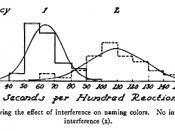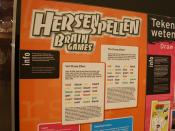Introduction.
The 'Stroop Effect' was first introduced in 1935. It originated from the theory of automatic processes. It is clear that some processing activities become automatic as a result of prolonged practice eg. Typing, driving, etc. Automatic processes therefore are fast, require no attention and are unavoidable. Stroop believed that there was some evidence that word identification may be a form of an automatic process. In the experiment participants had to name the colours in which the words were printed as rapidly as possible. It was shown that naming speed was slowed when the words were conflicting colour names. The 'Stroop Effect' suggested that the word meanings were extracted when the participants were not attempting to process it. The original 'Stroop Effect' was illustrated using colour. Flowers et al. developed another version of the 'Stroop Effect' in 1979. Instead of using colour the new version was illustrated using numbers.
The task was to say aloud the number of characters, which appeared. These characters appeared in both numerical and image format. Therefore the participants found it very difficult to resist saying the number they saw rather than the number of characters which appeared. The current study was a partial representation of the Flowers et al. study.
Method:
The experimenter first of all instructed the participants to turn on the computer. The participants were then asked to open the necessary file. Instructions appeared on the screen describing to the participants what was going to happen next. The participants were instructed to place four fingers on the keys 1 to 4 along the top of the keyboard. Participants were then told to illustrate using the numbers 1 to 4 how many figures appeared on the screen at a time and not to be distracted by...



Good
Gives a basic description of the stroop effect, although for a report is a little short, more detail within the results and discussion section could give it more strength.
1 out of 1 people found this comment useful.